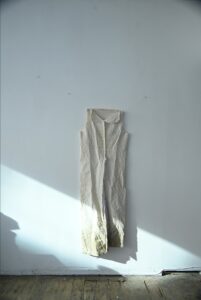
Installation View courtesy Saatchi Gallery
Artists of Today who Inspire Artists of Tomorrow Saatchi Gallery, London, UK (November 30, 2016–February 28th 2017)

Works by Richard Aldrich, David Brian Smith, Dexter Dalwood, Raffi Kalenderian, Ansel Krut, Martin Maloney, Bjarne Melgaard, Ryan Mosley and David Salle
I anticipated this exhibition with mixed feelings. I wonder are these artists all they’re cracked up to be, or products of a genius marketing job? As an arbiter of good and relevant contemporary art Saatchi is doubted by many, indeed he has been accused of its ‘commodification’ and this exhibition is drawn from his own collection.
The Saatchi Gallery is impressive – a stately columned building with 70,000 square feet of pale wooden floors, over which float pristine white walls, lit to perfection.
What artist wouldn’t dream of exhibiting their work in such a perfect setting? It would be hard to make work look bad in this space, indeed, I would venture to suggest that bad work could be made to look good. Which brings me back to the oddly named Painters’ Painters, redolent of that awful expression “mans’ man”. The underlying theme of this exhibition is that omen’s art is not as influential as men’s.
Large scale is obviously the way forward if you want to make it as a modern painter. Nothing in Painters’ Painters is small, and most of it is very loud in content and colour, subtlety is also in short supply.
The other burning question for me is why only nine artists? Of course it’s very neat that they just fitted into the nine rooms on the first two floors of the gallery, enabling each artist to have an entire room dedicated to their work. Some of it is not terribly recent, and none of it for sale at the moment.
I saw nothing that made me think “Yes, that’s it, that’s what I’ve seen influencing contemporary artists of the last decade”. I saw some good paintings, damn good in the cases of Ryan Mosely, David Brian Smith and David Salle, and decent in the cases of Dexter Dalwood and Raffi Kalendarian. But the collective works in this exhibition are being touted as the most influential for up and coming contemporary painters, and to “make it” their work needs to allude to these nine painters and their like. It is a narrow focus. Shame. I thought we lived in more enlightened times.
Helen Coakes-Blundell
Helen Coakes-Blundell is currently studying BA (Hons) Painting, Drawing and Printmaking at Plymouth College of Art.
Volume 31 number 3 January / February 2017 p 32


the state of the art world is being manipulated by money making conglomerates, cliques and nepotistic groups.
It excludes education and replaces it with phoney grandeur.
great of you to visit this show and write about it. i d like to see the ‘damned good paintings’ and not bad paintings you refer to .
Nice point, Coakes-Blundell! “Bad work could be made to look good”. John Link writes that Stieglitz’s 1917 photograph of Duchamp’s urinal is what awakened interest in that otherwise mundane object. Could we show the same painting to two innocent people, tell one it’s the best painting in the world, and tell the other it’s flawed, and both would see what they were told? Psychology tells us the signals that leave the retina reach consciousness after various changes, from electrical to chemical at the synapses and back again, and that’s just on a physical level. Semiotic transformations occur as our brain organizes these signals so as to make sense to consciousness; this means our logic influences our vision. And yet, the persistence of vision gives us stability so we can trust our judgment, but only if we’re aware of our influences. Looks like there’s a doctoral thesis in how “bad work could be made to look good” and how that goes down in academia.